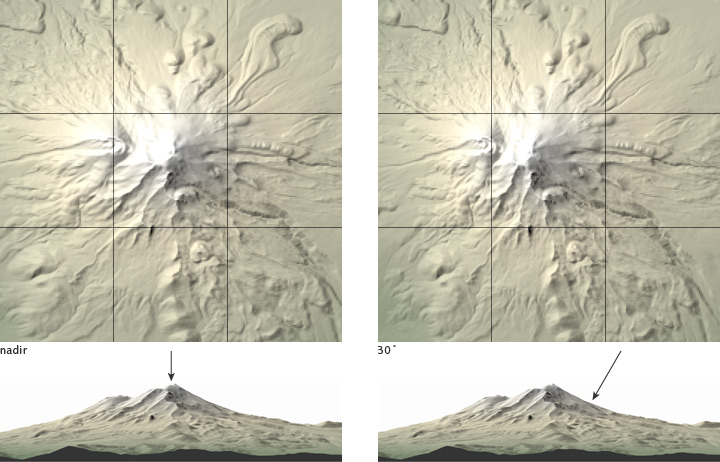

Anyone who has stood before a spectacular vista and taken a series of overlapping photos in the hopes of turning them into a panoramic image has probably experienced the frustration of trying to get the resulting photos to line up. You line up the mountains in the background, for example, and see that a road running through the foreground no longer overlaps.
These small distortions occur because as careful as you try to be when you take the picture, you can’t hold the camera at exactly the same angle as you shoot each image. You may lower the camera a fraction, or lean forward a tiny bit. Satellites experience the same small wobbles as they fly through space, and the impact on images is similar. Changes in the angle of view change the relative size and distance between features in the images.

Rugged terrain is a problem, too. If scientists don’t account for the topography when they turn the satellite data into images, the same landscape feature might look compressed in one image and stretched out in another, or it may appear to have shifted location by a several hundreds meters from one image to the next.
“It’s sort of like the image was on a piece of fabric, and it got wrinkled up,” says Masek. Smoothing the images out is critical for scientists who want to compare images of the same area over time or to combine satellite images with other types of geographic data, such population density, land ownership, or roads.
To correct the distortions (geographers call the process orthorectification), scientists have computers compare new satellite images to a library of ground control points. The control points are snippets of an image centered on a recognizable feature whose geographic information—latitude, longitude, and elevation—is precisely known from ground surveys. Computers identify features in the new image that match the control points, and maximize the alignment of all the features by resizing or rotating the new images.
The orthorectification of the 2005 version of the Global Land Survey is significantly more accurate than previous versions, mostly because of improved topographic data provided by the Shuttle Radar Topographic Mission, which flew on Space Shuttle Endeavor in 2002. For areas outside the United States, the Shuttle data improved the topographic detail by a factor of 10. “That alone resulted in dramatic improvement of geo-registration for many areas of the world,” said Dwyer.
The improvements were so dramatic that Masek and his collaborators persuaded NASA and the USGS to chip in some extra money to reprocess the 1975, 1990, and 2000 collections to match the 2005 Global Land Survey. NASA and the USGS are now working on the next iteration of the Global Land Survey, centered on imagery collected during 2009 and 2010.

“It’s kind of an amazing thing,” says Masek, “that the Landsat missions have been in operation since 1972, and only now are we getting to the point where we can use them at a global scale. We are hoping we can finally start to produce some of the global land cover assessments—urban growth, the extent of irrigated agriculture, etc—that were always the promise of the Landsat missions.”
The Global Land Survey 2005 project was funded by NASA’s Land Cover Land Use Change Program and the U.S. Geological Survey.